The Fitbit Sense 2 feels like a better watch for monitoring different aspects of your health but a worse smartwatch than the original Sense. If you want the best that Fitbit can offer on all fronts, then you might be best avoiding this one.
Pros
- Physical button is back
- Reliable resting heartrate data
- Strong sleep tracking features
Cons
- Sluggish software
- Missing smartwatch features
- Some new features not available yet
-
Good endurance6+ days battery life -
Ideal for pool useWaterproof up to 50 meters
Introduction
The Fitbit Sense 2 is the now Google-owned company’s second-generation smartwatch that’s very much focused on keeping tabs on both your physical and mental wellbeing.
This is still a smartwatch that finds room for sensors like ECG and skin temperature and can track heart rate 24/7 and blood oxygen during sleep. Now it also wants to keep much a closer eye on when you might be feeling stressed.
You’re also getting the Fitbit fitness and sleep tracking staples, along with something that will help you pay your way and can offer week-long battery life.
With Google’s own Pixel Watch now in the building, the question is whether Fitbit’s own smartwatches still deserve a place on your wrist.
Design and screen
- Thinner and lighter than Sense
- New physical button
- Colour touchscreen display
The Sense 2 doesn’t look too dissimilar to the original Sense, though Fitbit says it’s thinner and lighter. Putting it side-by-side with the first Sense and it’s not a marked change in how this watch feels to wear. You’ve still got a 40mm case that’s made from aluminium and a strap that comes in small or large size options, with both strap sizes included in the box.
The big change here is that Fitbit has decided to include a physical button and that’s definitely a big positive. Previously, interactions outside of using the touchscreen display were done by pressing the sides of the case. It was far from the ideal solution of having some form of physical control while also trying to offer a clean, uncluttered look. Sometimes buttons are a good thing and Fitbit has acknowledged it didn’t quite get things right when it ditched them.
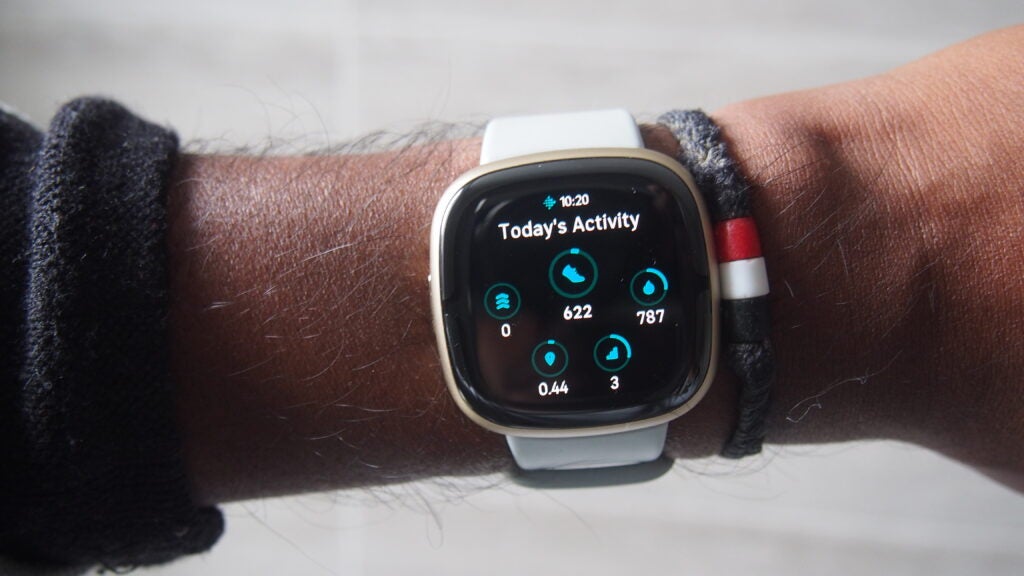
Things don’t seem to have drastically changed in the screen department where you’ll find a rectangular AMOLED touchscreen that can get pretty bright and provides vibrant, colourful surroundings to show off watch faces and stats. It does offer an always-on mode, though the raise to wake gesture support remains as disappointingly slow as it did on the first Sense.
If you like mixing things up on the strap front, that’s possible on the Sense 2 and it takes a simple button press to release the 24mm straps from the watch case. You’ll have to largely stick with Fitbit’s own official straps if you want to swap silicone for leather and also be happy to pay anywhere from £24-£50 for something smarter looking.
The silicone band attached to our Sense 2 did nicely compliment our case colour though the clasp setup makes it a very awkward strap to secure in place and it can take some fiddling around to get it right. Once it’s in place, it doesn’t budge, but getting a fit that’s a fine balance between something that sits snug enough for the sensors around the back to reliably track data and isn’t too uncomfortably tight to wear day and night is easier said than done.
Fitbit hasn’t budged on the level water resistance the Sense 2 offers, so it’s giving you something that’s fit to stay on in a shower or go for a swim as long as it’s not submerged in water beyond 50 metres depth.
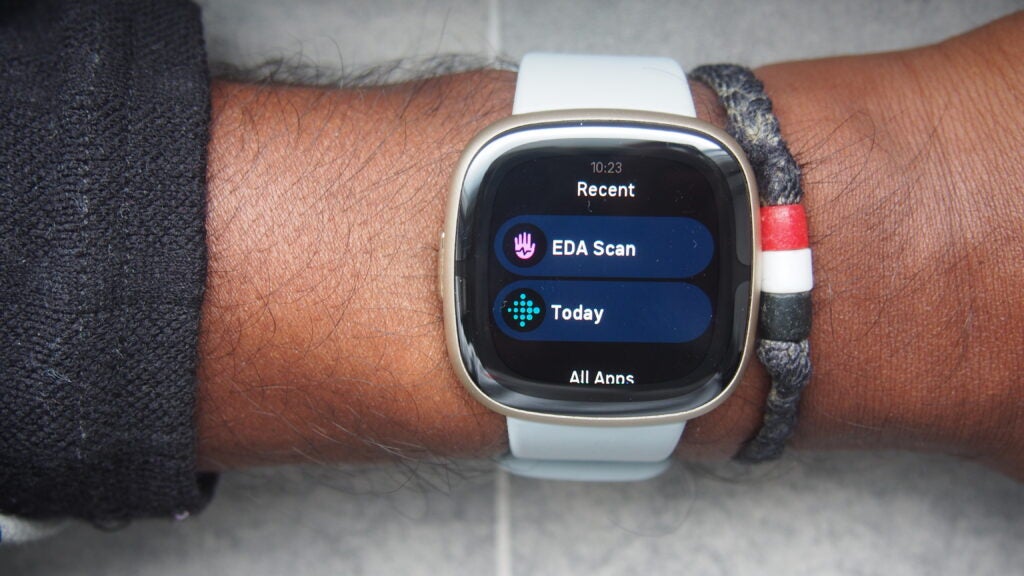
Features and performance
- Works with Android and iOS
- Latest Fitbit OS
- Google Maps and Google Wallet incoming
The Sense 2 runs on the latest version of Fitbit’s own FitbitOS operating system and it’s clear it’s had a bit of play with how the software is presented. Whether it’s for the better is certainly up for debate.
Previously, you swiped up from the main watch face to view Fitbit’s Today dashboard and swiping right from the sample place got you to the app screens. That’s now changed. Swiping up from the same place brings up your notification stream. Swiping left or right gets you to widgets for things like exercise tracking, weather, sleep data and heart rate stats. Pressing the physical button gets you to your apps and most recently used apps.
While getting used to the positioning of features is something you’ll need to adjust to, something you’ll not get used to is the very sluggish response you get swiping through screens and launching apps. Fitbit doesn’t talk processing power here, but whatever is powering the Sense 2 is simply not really cut out for the job.
Heading over to the Fitbit companion smartphone app and there are some interesting discoveries to be made here. While the core app looks familiar, delving into the Fitbit Gallery app store shows a distinct lack of third-party apps. Things like Strava, Uber, Deezer and Spotify are all absent.
That lack of music streaming app support also highlights that you’re not getting a built-in music player here either or any sort of music controls.
You can view notifications, use Fitbit Pay and there’s Amazon Alexa integration on board, but no option to choose Google Assistant. Fitbit has announced it’s going to add support for Google Maps and Google Wallet, but that support isn’t live yet. Interestingly, Fitbit has decided to deactivate the Wi-Fi support on the Sense 2 and cannot apparently be switched on either.
What is here works in a similar fashion to how it did on Sense, though you’re definitely getting a stripped-back smartwatch experience with laggy performance and it’s not clear if the third-party app support that was present for the first Sense will return on the Sense 2.
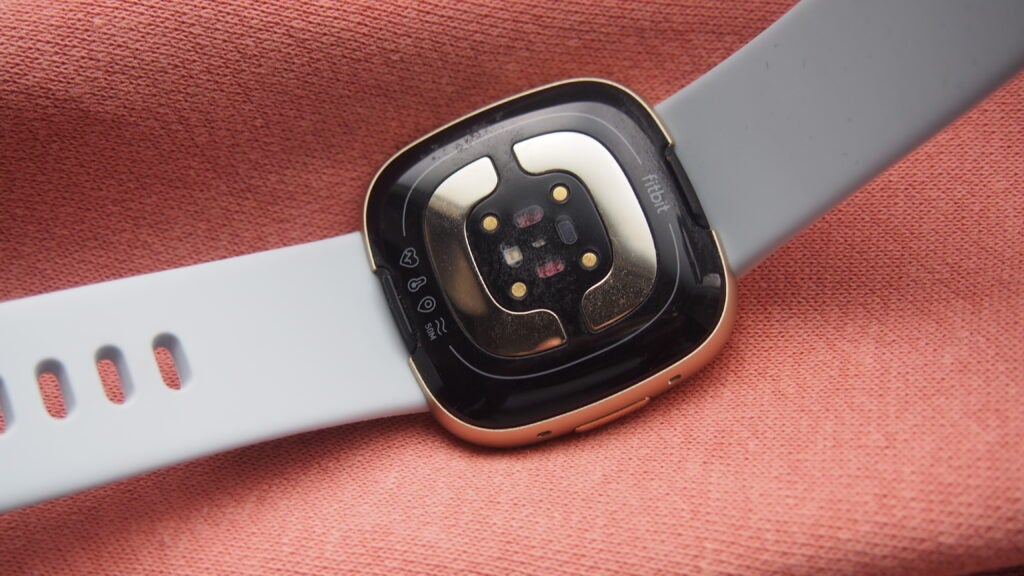
Fitness and health tracking
- All-day body response tracking
- ECG and skin temperature sensors
- Built-in GPS
Where things seem a little more normal is when you see what the Sense 2 can offer in terms of fitness and health monitoring features. It’s still a better health and wellness tracker than it is a sports tracker, so if you care more about steps, sleep and thinking about stress as opposed to getting super accurate and reliable exercise tracking, then this is one for you.
Daily step counts are easy to keep an eye on from the watch and the watch face and daily step counts were generally 500-800 steps within the same tracking on the Oura Ring 3. Sleep monitoring is a real strength for Fitbit and that’s no different on the Sense 2 in terms of the level of detail and accuracy of data. Elements like sleep duration and sleep stage breakdown were very similar to Oura’s own reliable sleep tracking support.
Fitbit has also introduced a new sleep profile feature, which sits behind its Premium subscription service, which you get six months of free access to when you set it up for the first time. You need to wear your watch for 14 nights to get an analysis of sleep time and among other things you’ll be assigned a sleep animal to illustrate your sleep behaviour. That animal can also be displayed on a dedicated watch face.
On the health front, the Sense 2 can track blood oxygen during sleep to help detect changes in your general wellness. There’s an ECG sensor and app once again to assess heart rhythm and help detect signs of atrial fibrillation. You’re also getting support for high and low heart rate alerts and resting heart rate readings. There’s also a skin temperature sensor, which like the SpO2 sensor, does its tracking business during the night to offer additional wellness insights. These all work in a similar fashion to how they did on the original Sense.
Fitbit has also made a much bigger push in recent years on the idea of paying closer attention to stress and specifically detecting when you might be feeling stressed. Along with features like guided breathing sessions, logging your mood and recording stress management scores, it’s adding the ability to track when your body may be under stress.
It’s doing that with an cEDA sensor, which is essentially an extension of the electrodermal activity sensor used in the first Sense offering those insights on a continuous basis. You’ll need to enable it in the Fitbit phone app first and you’ll be notified that turning it on will have a notable impact on battery life. Throughout the day you’ll see notifications asking you how you’re feeling to help build a sense of your mood during the day and help align it with the data it tracks.
You can still take on the spot EDA readings by placing your palm on top of the Sense 2’s screen where you’ll see heart rate changes, and EDA responses. The fewer EDA responses the better is the key here. You’ll get weekly summaries indicating stressful moments and then the watch will want you to choose to focus on something that might improve your ability to cope with stress, whether it’s through mindfulness sessions, looking at your sleep or daily activity.
It’s definitely a positive that Fitbit is taking a more focused look at stress and how that can impact other things in your life. The execution and joining the dots of it all still feels like it needs work, but it does feel like a part of the Fitbit (and Google’s ultimately) ecosystem that could grow to become more engaging, meaningful and motivational in terms of paying closer attention to those stress cues.
On the exercise tracking front, you’re getting built-in GPS and features like automatic exercise tracking, Cardio Fitness Scores and the ability to look at Active Zone Minutes and Daily Readiness Scores to better understand how hard you’re working out and when you should work out.
The core sports tracking experience doesn’t feel hugely different from the first Sense. It often took an age to pick up a reliable GPS signal during outdoor workouts and at times took so long that meant relying on accelerometer-based tracking instead. When you do lock onto a GPS signal the data still feels best suited to short 20-30 minute runs where you can get the most reliable distance and heart rate tracking data. Fitbit isn’t going deep into recovery and training analysis you can find on other watches around this price either if that’s what you’re looking for from it.
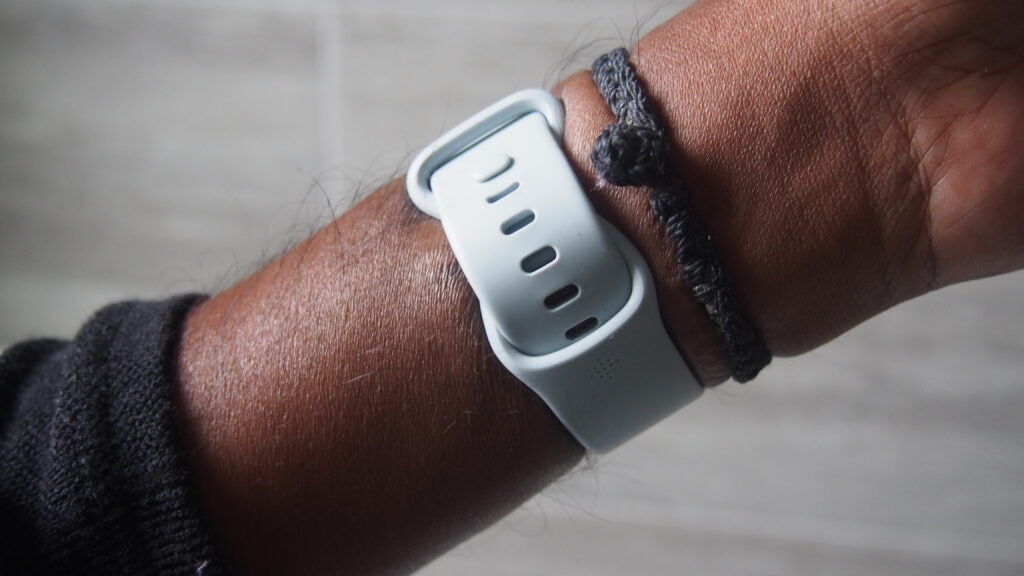
Battery life
- 6+ days battery life
- Quick charge battery life
- Up to 3 days in always-on mode
Unlike some of the best smartwatches, Fitbit’s smartwatches are capable of comfortably lasting a week and can even go a little longer, depending on the features you’re using on a regular basis.
Fitbit doesn’t dish out details on the size of the battery packed into the Sense 2 but does say it should last 6+ days. It also states that using features like the always-on display, SpO2 and cEDA sensor will see those battery numbers drop.
If you’re planning to use the GPS tracking on a regular basis, then Fitbit quotes 5 hours of GPS battery life, which is a sizable drop from the 12 hours promised on the original Sense.
Those daily and GPS battery numbers do seem to add up and daily drop-off was anywhere from 10-20%. When you put the always-on display into use, you’re looking at that daily number dropping to around 2-3 days.
Fitbit does also include a fast-charging feature, which gives you an extra day from a nippy 12-minute charge.
If you want a smartwatch that can hold up for a week, then that’s what the Sense 2 can deliver.
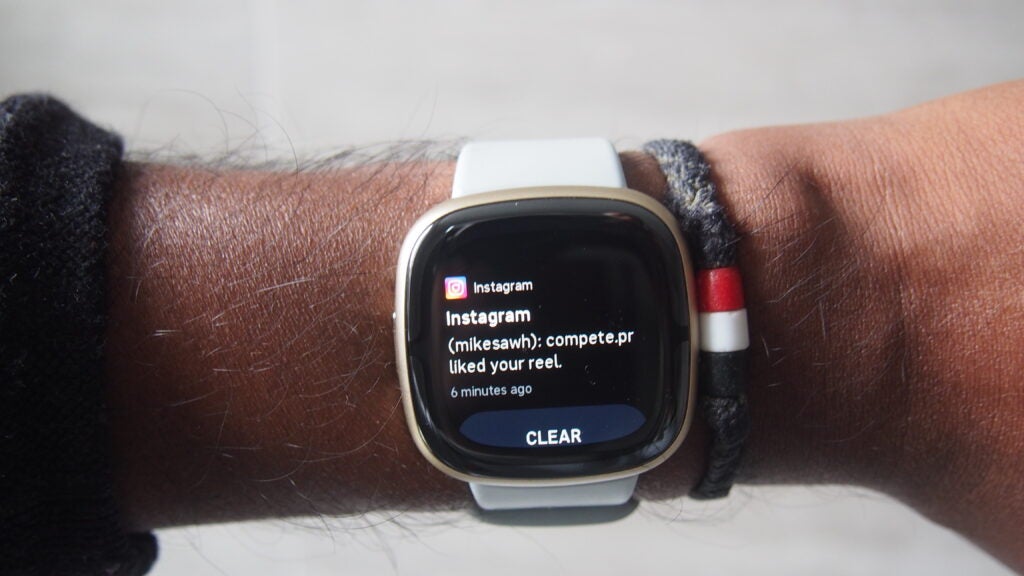
Should you buy it?
If you want a smartwatch that tracks sleep: Sleep monitoring remains a key strength for Fitbit and the Sense 2 offers a solid tracking experience overall when you take it to bed.
You want the best Fitbit smartwatch: The slightly sluggish software along with the missing smartwatch features means you might be better off buying the older Sense.
Final Thoughts
The Fitbit Sense 2 is a bit of an odd one. It offers a strong set of health and wellness monitoring features and it’s great to see a physical button in play here, but the sluggishness in the software and absent smartwatch features feels like a step back for the Sense. There’s a real feeling that this feels like a smartwatch caught between FitbitOS and WearOS and that’s not good for anyone.
FAQs
The Fitbit Sense 2 does have the ability to let you take calls when the smartwatch is connected to your phone by Bluetooth. This is a feature Fitbit says it will be adding soon to the Sense 2.
Unlike the Fitbit Sense, the Sense 2 doesn’t include a built-in music player to let you store music or stream from the smartwatch.
Sustainability
Trusted Reviews holds the fact that global warming is not a myth as a core value and will continuously endeavor to help protect our planet from harm in its business practices.
As part of this mission, whenever we review a product we send the company a series of questions to help us gauge and make transparent the impact the device has on the environment.
You can see a detailed breakdown of the questions we ask and why in our sustainability info page. In lieu of answering each of these questions, Vivo has provided us with its company Sustainability Report.
Jargon buster
ECG
An abbreviation for ‘electrocardiogram’. This is a test which can now be performed on some smartwatches to determine if there are any signs of arrhythmia in a person’s heartbeat – fluctuations that can result in severe health issues.
















